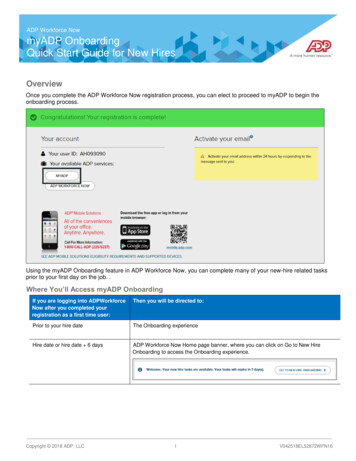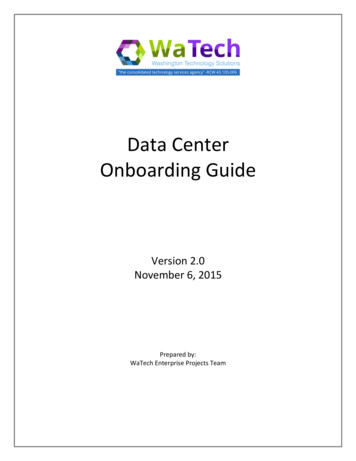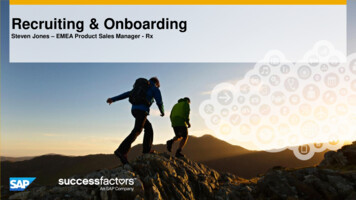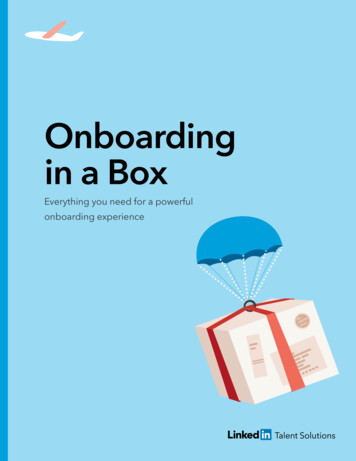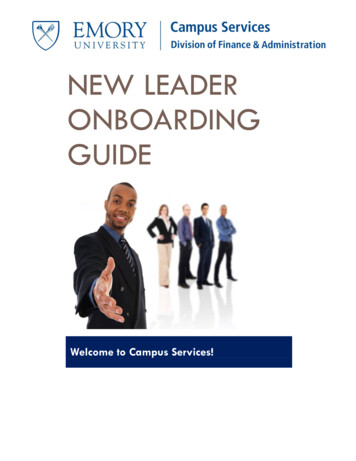
Transcription
NEW LEADERONBOARDINGGUIDEWelcome to Campus Services!
New Leader Onboarding GuideNew Leader Onboarding GuideWELCOME TO CAMPUS SERVICES!INTRODUCTIONWelcome to Emory University – Campus Services! We are pleased to welcome youas part of the Campus Services Leadership team. This guide is intended to provideyou with useful information and resources to assist you in making a successfultransition.WHAT IS ONBOARDING?Onboarding, including orientation, begins with the first day of employment andusually ends upon the first year of employment. It is a process that getsemployees up to speed with the policies, procedures, culture, expectations, andday-to-day responsibilities of their department/unit.We have adopted this process in Campus Services to: Ensure you feel welcomedBuild relationships with key stakeholdersIncrease engagement and satisfactionReduce the time it takes to “hit the ground running”Campus Services Page 1
New Leader Onboarding GuideWHAT IS THE DIFFERENCE BETWEEN ORIENTATION AND ONBOARDING?The following table outlines the differences:While the components of a traditional orientation program still apply, they nowbecome a “part” or “stage” of a much more comprehensive Onboarding process.Whereas, most orientation programs conclude by the end of the first or secondmonth on the new job, onboarding begins the first day and continues well beyondthe conclusion of the orientation program.Campus Services Page 2
New Leader Onboarding GuideWHY IS ONBOARDING IMPORTANT?Statistics show that employees are most vulnerable to leave an organizationduring the first 18 months after they are hired. Making a good impression istherefore paramount.Effective employee Onboarding serves five interrelated purposes:1. It builds Emory University’s REPUTATION for being a thoughtful employer,with great training, clear leadership, and strong structure.2. It helps RETAIN staff members.3. It REDUCES high turnover costs.4. It gets new employees to efficient PRODUCTIVITY levels quickly.5. It builds a COHESIVE TEAM, therefore raising EVERYONE’S productivity.WHOSE RESPONSBILITY IS ONBOARDING?Onboarding is successful only when Campus ServicesHuman Resources (CS-HR)/Training and Communications(T&C) and the hiring manager are all actively involved.The goal of this partnership is to establish a long-termrelationship with the employee that begins as soon as theemployee comes onboard.While CS-HR/T&C plays a key role in the early recruitmentand orientation and in guiding the Onboarding process,the hiring manager must be proactive and engaged infacilitating the employee’s successful integration into theorganization over time.ONBOARDING PROGRAM IN CAMPUS SERVICESYou will be oriented to the policies, culture, expectations through a series oflearning events including: A comprehensive New Leader Onboarding checklistOpportunities to engage in one-on-one meetings with key contactsAn assigned new hire coachProfessional development training sessionsRegularly scheduled meetings with your LeaderCampus Services Page 3
New Leader Onboarding GuidePROGRAM COMPONENTSThe New Leader Onboarding Program is broken down into five phases with keyactivities over the course of 1 year:Phase 1: First Day/First WeekPhase 2: 1st month (30 days)Phase 3: 2nd month (60 days)Phase 4: 3rd month (90 days)Phase 5: remainder of 1st year ofemploymentROLES & RESPONSIBILITIESNew Hire Uses the New Leader Checklist and supporting resources to manage theprocessEngages with the hiring manager at the defined times during the processCompletes all New Leader Learning SessionsHiring Manager Provides direction, coaching and feedback while building knowledge andhelping establish key relationshipsUse the New Leader Checklist and supporting resources to facilitate asmooth transition for the new hireAssigns a new hire coachReserves time to communicate with the New LeaderCS Human Resources/Training & Communications Overall process ownerServes as advisor to walk/talk through Onboarding and transitioningchallengesGathers feedback and evaluates the program on an ongoing basisCampus Services Page 4
New Leader Onboarding GuidePROCESS CHART FOR ONBOARDING A NEW LEADER IN CAMPUS SERVICESPre-arrival: Hiring Managerorganizes workspace, createsan arrival agenda, assignsnew hire coachFirst Day: New Leader iswelcomed, introduced toworkspace, co-workers.First Week: Discussion of RRE’s,organization/department goals.Overview of list of key contacts.Meet with New Hire Coach.1st month: New Leader goalsare established and enteredin to CSB. Meet with staff.Schedule meetings with keycontacts. Continuousfeedback with your leader.2nd month: Continue tomeet with key contacts.Schedule applicable trainingsessions. Continuousfeedback with your leader.3rd month: Attend applicableworkshops. 90-day feedback anddevelopment discussion with yourleader (this is a signed form thatshould be submitted to CS-HR).3rd month – end of 1styear: Attend applicableprofessional developmenttraining sessions as theybecome available (refer tonew leader onboardingchecklist)Campus Services Page 5
New Leader Onboarding GuideTIPS ON MAKING YOUR FIRST 90 DAYS SUCCESSFULStarting a new job with leadership responsibilities can be extremely exciting andinvigorating. You have spent time researching, preparing for the interview andpossibly negotiating your compensation. Your next step is to give some thought towhat you’re going to be doing during the first 90 days on the job as it has greatpractical and symbolic importance. The first 90 days offers a unique window ofopportunity to establish relationships, set a tone and identify expectations.The following section provides a few tips on how you can ensure your transitionwithin the first 90 days is a smooth one.NEW LEADER ONBOARDING CHECKLISTThe purpose of the New Leader Onboarding Checklist is a “to do” list with criticalelements, resources, and learning sessions that should be completed within thefirst day, first week, and first 30, 60 and 90 days. The intent of this document isone of a collaborative approach between you and your leader. (Refer to the NewLeader Onboarding Checklist provided).PLANNING FOR IMPORTANT CONVERSATIONSYour relationship with your leader will be built through a continuing dialogue. Yourdiscussions will begin before you accept the new position and continue into yourtransition and beyond. To help you make a smooth transition, there are someimportant conversations that will help you engage with your leader.1. Roles, Responsibilities, Expectations (RREs) & Goals:a. Your agenda for this conversation is to understand your responsibilitiesand what expectations your leader has of your position. What doesyour manager need you to do in the short and medium term?b. As a part of the Campus Services Feedback and Development Process,your RRE’s are translated into goals. These goals are loaded into theonline performance management tool (CSB). What does success looklike? How will your performance be measured?2. Communication Style: This conversation is about how you and yourmanager interact on an ongoing basis. Is it face-to-face? In writing? Byvoicemail or e-mail? How do your styles differ and how will you negotiatethose differences?3. Resources: This conversation is a negotiation of resources. What is it thatyou need to be successful? What do you need from your leader? This maynot always be physical resources but rather, help from your leader topersuade the organization to confront the need for change.Campus Services Page 6
New Leader Onboarding Guide4. Professional Development (this conversation should occur after the 1st 6months of employment): Discuss how your tenure in this job will contributeto your professional development. Are there projects that you canundertake? Are there courses or programs to further develop your skills?BELONGING AND FEELING CONNECTEDYour leader or designate will provide you with a list of keycontacts/stakeholders/staff members for you to meet within your first 90 days ofyour Onboarding Program. Start by meeting with your direct reports as a groupand one-on-one and then meeting with key contacts. You will need to decide inwhat order you will meet with them. Be careful to avoid being excessivelyinfluenced by what the first couple of people say to you. One approach is to keepthe same “script” in all your meetings. The format might consist of brief openingremarks about yourself and your approach, followed by questions about the otherperson and then a standard set of questions about the business. The following aresuggested questions:1. What are the biggest challenges the department is facing (or will face) in thenear future?2. Why is the department facing these challenges?3. What are the most promising opportunities for growth?4. What would need to happen for the organization to develop theseopportunities?5. If you were me, what would you focus your attention on?Asking these questions will assist you in identifying prevalent and divergent views.You will learn about substance and team dynamics and begin to identify keyissues.Campus Services Page 7
New Leader Onboarding GuideUNDERSTANDING THE ROLE OF A NEW HIRE COACHResponsibilities of New Hire Coach: To help welcome the new leader to Campus ServicesBe an informational resource for the new leader by answering generalquestions regarding day-to-day aspects of working in Campus ServicesHelp in the socialization process by introducing you to key individuals andgroupsBe a resource for work rules, and workplace culture and normsMaintain confidentiality as appropriateSELECTION OF A NEW HIRE COACHNew Hire Coaches are selected by the hiring manager of the new leader. Thefollowing qualities are preferred when selecting a new hire coach: Has patience and effective communicationskillsDemonstrates strong work performanceExemplifies Campus Services CoreCompetencies: Building Trust, CustomerFocus, Effective Communication, andLeveraging DiversityWorks in the same department and/or hassimilar roleCan devote the time to be accessible to thenew leaderShows interest in being a new hire coachQUESTIONS FOR A NEW HIRE COACHThe following is a list of types of questions that anew hire coach should be able to answer or toassist with finding the answers:Getting Started Where do I find ?What resources are available to help with ?Who would I contact for information about ?Campus Services Page 8
New Leader Onboarding GuideDay-to-Day Work Tasks How do I ?What is the process for ?Where do I get help with completing ?What do you think about ?Would you be able to show me ?Could you help me with ?Understanding the Work Environment Are there certain events or meetings that I should attend?What has proven successful in the past?What’s the protocol on ?Who do you think would support me on ?CONTINUOUS FEEDBACK AND COMMUNICATIONEffective Onboarding means keeping in touch with your leader as you becomemore familiar with the organization. It also means actively finding out how you’redoing and making it easy to discuss what’s on your mind. It is recommended tohave weekly or bi-weekly “check-in” meetings with your leader.FEEDBACK AND DEVELOPMENT MODELCampus Services Page 9
New Leader Onboarding GuideREFERENCESThe First 90 Days: Critical Success Strategies for New Leaders at All Levels by MichaelWatkins (2002)Right From The Start: Taking Charge In A New Leadership Role by Dan Ciampa andMichael Watkins (1999)University of California, Davis http://www.hr.ucdavis.edu/sdpsUniversity of Delaware http://www.udel.edu/onboarding/York University www.yorku.ca/hr/hrlearn.htmlCampus Services Page 10
within the first 90 days is a smooth one. NEW LEADER ONBOARDING CHECKLIST The purpose of the New Leader Onboarding Checklist is a "to do" list with critical elements, resources, and learning sessions that should be completed within the first day, first week, and first 30, 60 and 90 days. The intent of this document is

